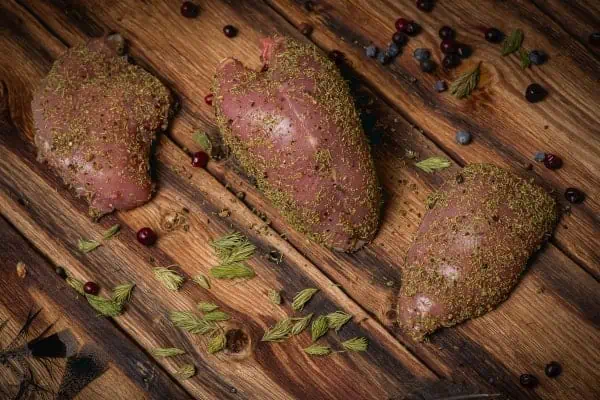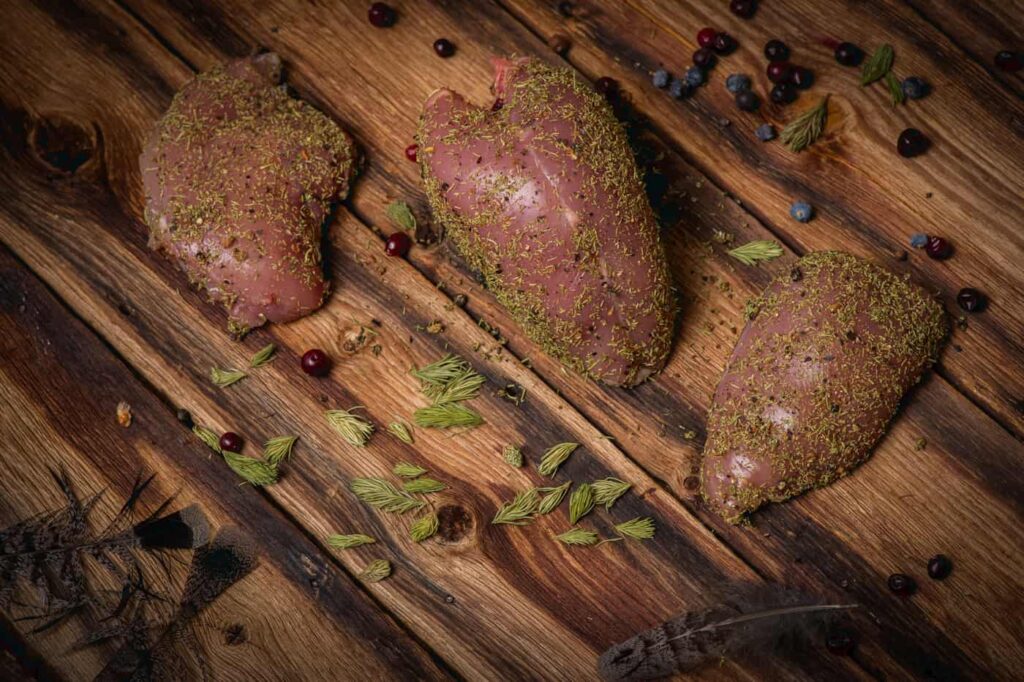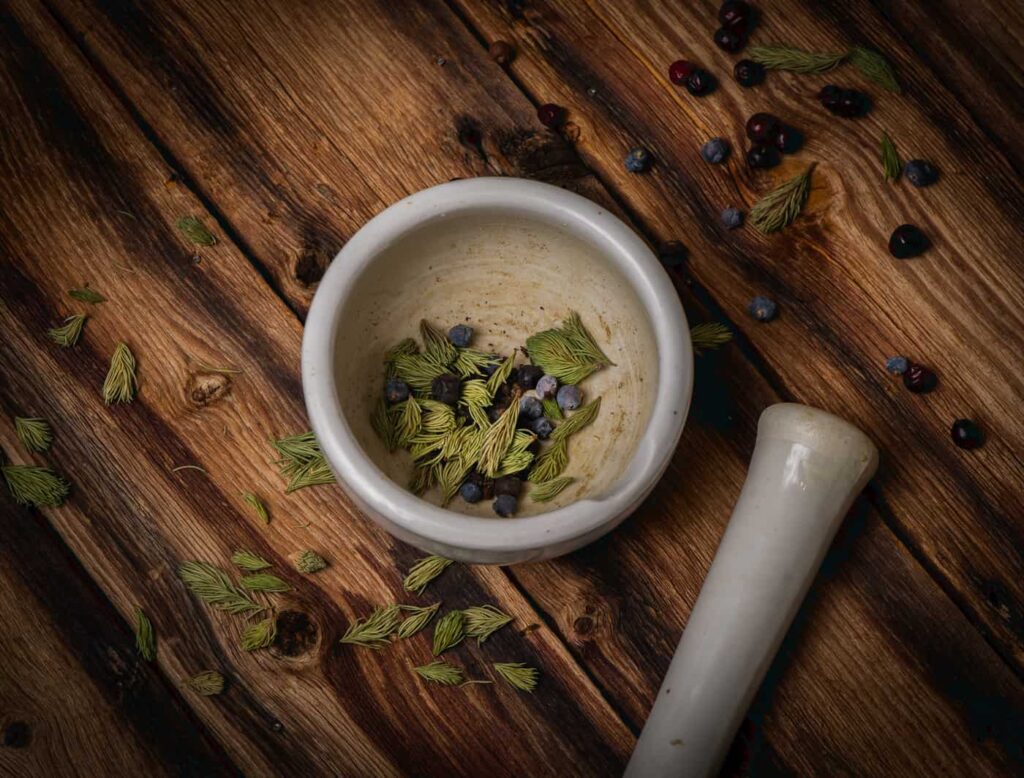
Sautéed Ruffed Grouse Breasts In Madeira And Cranberry Sauce
Ingredients
- 1 cup Madeira
- 1/2 cup low-bush cranberries
- 2 ruffed grouse breasts, split and boned (reserve bones for stock)
- 1 Tbsp dried spruce tips*
- 1 tsp Labrador tea leaves*
- 1/2 tsp black peppercorns
- 2 Tbsp butter, divided
- 2 cups chicken or turkey stock
- 2 Tbsp each of diced carrot, onion and celery
- *Substitute 1 tsp each of dried thyme and rosemary for the herbs
Instructions
- Two to three hours before you intend to serve, soak cranberries in Madeira.
- Make the stock: sauté the grouse bones and vegetables in 1 tablespoon butter in a small, heavy saucepan until vegetables are beginning to brown.
- Add the turkey or chicken stock and bring to a boil. Reduce heat to medium-low and simmer uncovered for 1 hour. Strain the liquid, measure and return to heat until reduced to one cup (250 mL). Set aside.
- Grind Labrador tea leaves, spruce tips and black peppercorns in a mortar and pestle. Drench breasts in seasonings and let sit at room temperature for 30 minutes.
- Pour Madeira and cranberries through a strainer. Set liquid and berries aside in separate bowls. Reserve 1 tablespoon cranberries for garnish.
- Thirty minutes before serving, melt remaining butter over medium heat in a cast-iron frying pan. When butter is sizzling, add grouse breasts and sauté for 3 minutes on each side. Remove from heat and let sit on a plate, uncovered, while you make the sauce. The meat will continue to cook as it rests.
- Still over medium heat, deglaze the pan with half the Madeira, scraping up any browned bits. Add the remaining Madeira, the turkey stock and the cranberries (minus the reserved tablespoon) and cook until reduced to a light syrup, enough to hold its shape but not thickened like cranberry sauce. If you do somehow cook the sauce too long, remove it from the heat and beat in a couple of tablespoons of cold butter.
- Carve each breast into four thick slices. Pour a pool of sauce on each of four dinner plates and arrange the slices in a fan on top. Sprinkle with a few cranberries and serve at once on heated plates. Bring any remaining sauce to the table (there won’t be much).


We met Roger Kempanien in a youth hostel on the outskirts of Gällivare, an iron-mining town in northern Sweden. My husband and I were on a food tour of Sweden, Norway and Finland, gathering recipes for my second cookbook, The Boreal Feast. Roger walked towards us down the corridor, a strong middle-aged man of medium build with a kind, open face, carrying two bowls of steaming dog food. Roger is a hunter, and like every Swedish hunter, he has hunting dogs whom he loves and expects much of.
He and his dogs were in Gällivare to take part in a competition: the dogs had to do clever things in a difficult, simulated hunt, and they had to do them elegantly and well. One of Roger’s dogs was a young female who was very smart but tended to lose the plot at crucial moments. The next day would be her test. Roger hoped she would flush a fjäll-ripa on the mountain.
Sweden’s fjäll-ripa is our rock ptarmigan, or Lagopus muta, found in the subarctic and Arctic tundra, nesting on stones. Until I went to Sweden, my culinary experience of the grouse family, to which the ptarmigan belongs, was limited to the spruce grouse (ptarmigan had not come my way).
Roger’s young female dog didn’t do so well in the competition; she might have had a chance, but it snowed on the fjäll (mountain) and then it got foggy, so the day ended early. That night, Roger and the other hunters told stories over a couple of whiskies at the youth hostel, and by the way, the young hunters listened to Roger (we could tell he was someone they admired). At the end of the night, Roger invited us to visit him in his hometown of Luleå on the Baltic Sea. Perhaps he would cook us a fjäll-ripa.
We found his house in a quiet suburb of Luleå, a couple of weeks later. Roger and his partner Birgitta welcomed us into a home lit with candles and decorated in the simple, pretty way that Scandinavians are so good at. We stood at the kitchen counter and ate flatbread, melted Västerbottensost and cloudberry preserves, while Roger prepared the main course: breast of fjäll-ripa, cut into pieces and sautéed in butter, with chanterelles and bacon, then braised in a stock made with ptarmigan bones and finished with cream. We had lingonberry sauce to accompany, and Birgitta made potato cakes with Västerbottensost to go with the fjäll-ripa. We dined by the light of many candles and ended the evening with a singalong of ’70s songs.
In the fall of 2013, a year after we met Roger, Cathie Archbould came home with two ruffed grouse and invited me up to her place to cook it for us and our partners. This was my third culinary experience with the grouse family. After dinner, we did not sing ’70s songs, but we did sing the praises of the ruffed grouse, whose meat is mild in flavour, light in colour and cooks up quickly.
The Boreal Feast, published in 2014, is now out of print and I am thumbing through it and remembering good times and good friends, both here and abroad. I hope you enjoy this recipe as much as I do. (If you were not blessed with ruffed grouse this hunting season, try it with local chicken breasts, but you’ll need to cook them a little longer.) As always, many thanks to the hunters.
Serves 4.




